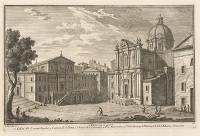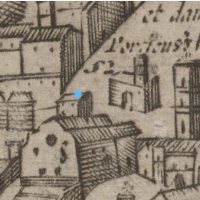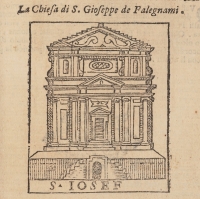Even though Santa Martina ceased to be a parish church after the transfer of the Università dei Pittori there in 1588, San Giuseppe dei Falegnami remained under its longstanding jurisdiction. Because of the change in administration of Santa Martina, the carpenters tried to renegotiate their contract. In the end, after refusing to pay rent for some time, they reached an agreement with the Accademia di San Luca in 1630, when the principe was Gian Lorenzo Bernini (1598–1680) and the governatore of the Arciconfraternita di San Giuseppe was Giovanni Battista Soria (1581–1651). [6] Soria may have been called upon for the successful mediation of the conflict owing to his concurrent membership in the Accademia di San Luca. [7] The effort of the Arciconfraternita to establish jurisdictional independence from the Accademia must have spawned rumors in the period if Pompilio Totti considered the issue worth mentioning in his Ritratto di Roma moderna (1638). As documents reproduced on this website demonstrate, negotiations about certain details of the concession of the site lingered even after the 1630 agreement. [8]
- Filters:
- Sort by:
- Results layout:
Selected Bibliography
Anderson, Paul. "The Archiconfraternita di San Giuseppe and the Università dei Falegnami: The Development of Professional Institutions in Early Baroque Rome," in The Accademia Seminars: The Accademia di San Luca in Rome, c. 1590‒1635, edited by Peter M. Lukehart, 289–323. Washington, 2009.
Caiola, Antonio Federico, and Luciana Cassanelli. Roma sacra: Guida alle chiese della città eterna. Vol. 3. Pozzuoli (Naples), 1995.
Felini, Pietro Martire, and Prospero Parisio. Trattato nuovo delle cose maravigliose dell'alma citta' di Roma. Rome, 1615.![]()
Hibbard, Howard. "Di alcune licenze rilasciate dai Mastri di Strade per opere di edificazione a Roma (1586‒89, 1602‒34)." Bollettino d'arte 52 (1967): 99–101.
Lukehart, Peter M., ed. The Accademia Seminars: The Accademia di San Luca in Rome, c. 1590–1635. National Gallery of Art, CASVA Seminar Papers 2. Washington, 2009.
Missirini, Melchiorre. Memorie per servire alla storia della Romana Accademia di S. Luca fino alla morte di Antonio Canova. Rome, 1823.
Montano, Giovanni Battista. Scielta d. varii tempietti antichi con le piante et alzatte desegnati in prospettiva. Rome, 1624.![]()
Montano, Giovanni Battista. Li cinque libri di architettura. Rome, 1691. Reprint.![]()
Piatti, Tomaso. Il carcere Mamertino: La chiesa di S. Giuseppe dei falegnami e il santuario del SS. Crocifisso. Rome, 1938.
Panciroli, Ottavio. Roma sacra, e moderna già descritta ed accresciuta da Francesco Posterla abbellita con nuove figure e di nuevo ampliata e riordinata da Gio. Francesco Cecconi aggiuntovi dal medesimo un diario istorico dell 1700 fino all'anno 1724. Rome, 1725.
Purpura, Gianfranco. "Nascita d'una regia università: Il convento dei Teatini e l'oratorio di S. Giuseppe dei Falegnami." In Organismi: Il sistema museale dell'Università di Palermo; percorsi, saggi, schede, ed. Aldo Gerbino, 53–61. Naples, 2012.
Tiberia, Vitaliano. "S. Giuseppe dei Falegnami: Notizie storiche." Palladio 21 (1971): 184–188.
Titi, Filippo. Descrizione delle Pitture, Sculture e architettura esposte ad pubblico in Roma; opera cominciata dall'Abate F. Titi con l'Aggiunta di quanto è stato fatto di nuovo fino all'anno presente. Rome, 1763.
Totti, Pompilio. Ritratto di Roma moderna. Rome, 1638.![]()
Vasi, Giuseppe. Delle magnificenze di Roma antica e moderna. Rome, 1753.
Zandri, Giuliana. S. Giuseppe dei Falegnami. Rome, 1971.
San Giuseppe dei Falegnami was founded when a branch of carpenters (the Compagnia dei Trenta Falegnami) broke from the larger Università dei Muratori et dei Falegnami in 1540. [1] The group convinced the rettore of the Church of Santa Martina to allow them to rent the Church of San Pietro in Carcere, which at the time was under the legal jurisdiction of Santa Martina. [2] The Church of San Pietro was small, subterranean, and located in a relatively lightly populated area of the city, the ancient Roman Forum, then known as the Campo Vaccino, or cattle field, a name based on its function. Despite its size and situation, the Church of San Pietro was an important pilgrimage site for several reasons. First, it was the place where the apostles Peter and Paul had been imprisoned before suffering martyrdom. Second, it was considered to have been consecrated as a church by Pope Sylvester I (reigned 314‒335) at the behest of Emperor Constantine the Great (reigned 307‒333). [3] When choosing the site, the carpenters must have counted on pilgrimage traffic to bolster their visibility in the city. In addition, they must have been attentive to economic factors. On the one hand, the small, obscure church could not command a high rent. On the other, if the site was properly managed and promoted, it could produce revenue. Indeed, the Compagnia succeeded in obtaining privileges and temporary indulgences from various popes. [4]
Throughout the remaining six decades of the 16th century, the carpenters worked at the site to improve the church to meet their requirements. In 1540, when they moved in, the place seemed not only inadequate for its intended use but also potentially impractical because of its underground location. Therefore, the carpenters decided to build a new church at ground level, to be dedicated to Saint Joseph, their patron saint. Initially they built a small church of wood, the preferred material of their profession. The availability of a relatively inexpensive material and of skilled workers would have facilitated speedy construction. [5]

Figure 1. Pirro Ligorio, Urbis Romae, detail of Church of San Giuseppe dei Falegnami, near Arch of Septimius Severus, c. 1552–1573, etching. Collection of Fredrika and Paul Jacobs

Figure 2. Étienne Dupérac, Nova Urbis Romae Descriptio, detail of the Church of San Pietro in Carcere, 1577, etching. London, The British Library
While Pirro Ligorio imagined the ancient building that had hosted the prison to be comparable in size with the nearby Arch of Septimius Severus [fig. 1], Étienne Dupérac’s map shows a small church with a bell tower [fig. 2]. The building on Dupérac’s map must have been the first stone Church of San Giuseppe dei Falegnami built on the site, constructed in 1543‒1546, with a bell tower added in 1563. [9] Although it is San Giuseppe that is delineated, the corresponding label on the map reads “Car[cere]. S. Petri,” reflecting the importance of the site as an apostolic locus, the place where Saint Peter and Saint Paul spent the last nine months of their lives before suffering martyrdom. [10]
Even later, when the new and more imposing Church of San Giuseppe dei Falegnami was complete, Giuseppe Vasi titled his engraving depicting the site San Pietro in Carcere [fig. 3]. When the Università dei Pittori moved to the Church of Santa Martina, the carpenters’ church looked close to the way it was rendered on Dupérac’s map. Unfortunately, on the Tempesta map, which would otherwise have shown the church just before the late 16th-century reconstruction, the site is totally blocked by the Palazzo Senatorio on the Campidoglio. Although adopting a similar angle to Tempesta’s map, Matteo Florimi included a depiction of San Giuseppe dei Falegnami (c. 1590–1613; fig. 4). However, the structure lacks its standard characteristics, such as the bell tower visible on Dupérac’s map. In contrast, Florimi depicted the medieval tower that topped the neighboring Arch of Septimius Severus but changed its location to the opposite end. Thus, the generic aspect of San Giuseppe dei Falegnami on Florimi’s map conforms with his relative attention to detail.

Figure 3. Giuseppe Vasi, San Pietro in Carcere, in Delle magnificenze di Roma antica e moderna, 1753, fig. 42. Mark J. Millard Architectural Collection, David K.E. Bruce Fund, 1985.61.2732
The first stone Church of San Giuseppe was decorated by Benedetto Bramante between 1551 and 1553, principally with a painting depicting the betrothal of the Virgin and with two other episodes from the life of Saint Joseph. [11] The structure was enlarged and redecorated two decades later, between 1574 and 1578, and extended only a decade later, between 1584 and 1585. Sixtus V allowed the carpenters to build a cemetery next to the church and to use a subterranean chapel. [12] The latter privilege would lead to a four-level structure, the upper two levels constituting the Church of San Giuseppe dei Falegnami and the lower two, the church of San Pietro in Carcere. [13] The subterranean chapel, a buffer between the ancient prison space and the new church, took its current form and dedication only in 1853. It received a crucifix and was consequently named the Cappella del Santissimo Crocifisso. [14]

Figure 4. Matteo Florimi, Novissima urbis romae descriptio, detail of Church of San Giuseppe dei Falegnami, c. 1590-1613, ething and engraving. Collection of Fredrika and Paul Jacobs
It seems, however, that even the enlarged building was not adequate for the needs of the growing membership of the Arciconfraternita di San Giuseppe. In the summer of 1597, the Arciconfraternita decided to construct an entirely new church. Although 18th-century sources attribute the architectural concept to Giacomo della Porta, modern scholars, on the basis of archival evidence, have assigned the authorship of the project to Giovanni Battista Montano (1534–1621). [15] Montano, like Soria, was also a member of the Accademia di San Luca, where in 1594 he gave a lecture on architecture. [16] The completion date of the church is considered to be 1602, when masses began to be celebrated there. [17] Despite the delay in launching the construction, the carpenters must have originally intended to have the church finished for the Jubilee of 1600. It would have been not only a sign of institutional pride on the part of the carpenters but also a sign of economic perspicacity for, as explained above, the church had substantive pilgrimage potential. Concomitantly, the role of governor (governatore) entrusted to Montano by the Arciconfraternita in 1601 may be an indication that he received the title as a reward for bringing the church by then to a satisfactory state of completion.
Just as the artists had to raise funds to improve the derelict Church of Santa Martina, the carpenters relied on taxation and donations for new construction at San Giuseppe. In the summer of 1598, the Arciconfraternita approved unification with the Università dei Falegnami, the institution from which the Compagnia had split in 1540. [18] Approval came a year after discussions for a new church had been initiated, but talks may have started earlier. A plausible scenario is that the union triggered the initiative for a new building. In the end, the construction of the new church benefited from the union: the Università paid a one-time fee to be used for the erection of the new building. [19]

Figure 5. Pietro Felini and Prospero Parisio, Church of San Giuseppe dei Falegnami, in Trattato nuovo delle cose maravigliose dell'alma citta' di Roma, 1615, p. 153. National Gallery of Art Library, Rare (NA1120 .F44 1615)
An illustration in Pietro Martire Felini’s Trattato (1615; fig. 5) shows the church not long after its completion. The Church of San Giuseppe stands on the ground-level story of the Church of San Pietro. Its facade is set a few steps back in relation to the entrance wall of the Church of San Pietro, allowing room for an open terrace. As Vasi’s 18th-century print shows, both the terrace and the stairs leading to the underground Church of San Pietro were subsequently fitted with balustrades. The facade is on two levels, though the separation between the two may be considered an intermediary level rather than simply a stringcourse. A similar separation between two levels can be seen in Carlo Maderno’s contemporary facade for the Church of Santa Susanna (1603). While Maderno’s facade is considered a landmark of early baroque architecture, Montano’s name barely surfaces even in specialized literature because his principal specialty was carpentry. In fact, the Church of San Giuseppe dei Falegnami was Montano’s sole architectural work. He was instead invested in drawing and publishing views of ancient monuments. [20] It has been proposed that his fame as an architectural theorist was the reason not only for his admittance to the Virtuosi ai Pantheon in 1579 and his status as a founding member of the Accademia di San Luca, but also for being commissioned for the Church of San Giuseppe. [21] Regardless, the facade of San Giuseppe dei Falegnami merits comment. Whereas Maderno extended a central projecting bay into the upper pediment of Santa Susanna, Montano added an unusual decorative detail to the same area of the facade of San Giuseppe, repeating the geometry of its pediment in a smaller one on either side. This detail confers an extra layer of ornament to a surface already enriched with refined stucco decorations and the play of geometrical shapes (squares, rectangles, an oval window, and so on). The church has a single-nave plan, with shallow chapels on each side. Evidently, the Arciconfraternita expected pro bono work from Montano but graciously named him its governor (governatore) in 1601.

Figure 6. Giovanni Battista Falda, Nuova pianta et alzata della città di Roma, 1676, detail of Church of San Giuseppe dei Falegnami. Biblioteca di Archeologia e Storia dell’Arte, Rome
After Montano’s death, Giacomo Battista Soria became the architect in charge. [22] He was responsible for the enlargement and completion of the adjacent oratory and sacristy. The interior was frescoed in phases in the following centuries, the older decoration being the work of an unknown 17th-century painter who was visibly inspired by Pietro da Cortona. [23] The collapse of the wooden ceiling in 2018 produced incredible damage, but thanks to rapid restorative interventions the church was refurbished by January 2021.
Giovanni Battista Falda’s map (1676; fig. 6) offers the most detailed view of the complex, the shapes of both the church and the isola being well contoured. Intriguingly, Joachim von Sandrart’s view of the same area in a map published the following year (1677; fig. 7) apparently recorded an earlier phase of the site in which the church is undistinguishable from the cluster of buildings surrounding it. Taking into account his curious rendition of the Arch of Septimius Severus as an enclosed temple-type building, Sandrart’s map serves as an exercise in the use and interpretation of sources rather than as historical evidence for the site. [24] Furthermore, maps did not transmit any information about the underground spaces.

Figure 7. Joachim von Sandrart, Recentis Romae ichnographia et hypsographia, 1677. Collection of Fredrika and Paul Jacobs
With regard to the dedication of the church, Totti (1638) was right to question the paucity of churches in Rome dedicated to Saint Joseph (only two at that time). [25] This doubtless had to do with the problematic aspects of the figure of Saint Joseph in the economy of salvation, but the post-Tridentine policy toward him was more favorable, and the number of depictions of the saint increased considerably in the 17th century. Concomitantly, a new iconography was developed: a portrait type showing Joseph holding the infant Jesus. [26]
~ Silvia Tita, revised August 2021
[1] Thirty carpenters decided to form a new association under the name Compagnia Trenta Falegnami (Tiberia 1971, 184). The Università dei Muratori et dei Falegnami was located in the Church of San Gregorio Magno (formerly Santa Martinella) near Porto di Ripetta, a convenient location for accessing the construction materials that were entering the city on the Tiber River through this port. See Anderson 2009, 290.
[2] Zandri 1971, 14.
[3] For more on the location and the significance of the site of the Church of San Pietro in Carcere, see the entry devoted to it on this website.
[4] For instance, Pompilio Totti mentions those obtained from Pope Gregory XIII (1572–1585); see Totti 1638.
[5] The Compagnia’s statutes of 1590 and 1604 attest to the construction of this wooden building. See Anderson 2009, 295.
[6] For the Compagnia’s refusal to pay rent, see Anderson 2009, 294. The document of the agreement is summarized in a series of modern sources, including Anderson 2009, 294 and 317 n. 38.
[7] Documents on this website attest to Soria’s involvement in the Accademia in different capacities. See the entry on Giovanni Battista Soria.
[8] See ASR, TNC, uff. 15, 1633, pt. 1, vol. 135, fols. 232r‒v, 245r, and ASR, TNC, uff. 15, 1633, pt. 1, vol. 135, fols. 416r‒v, 441r‒v,
[9] For this hypothesis, see Zandri 1971, 15.
[10] For this topic, see the entry on San Pietro in Carcere.
[11] Zandri 1971, 22.
[12] Zandri 1971, 14.
[13] Giacomo Fontana’s engraved section of 1855 shows the four-level structure.
[14] The wooden crucifix, known as the Crocifisso di Campo Vaccino, dated from the medieval period, according to some, as far back as the time of Pope Sylvester I (Zandri 1971, 19). On the chapel, see Zandri 1971, 34–36; Anderson 2009, 295 and 317 n. 46).
[15] For 18th-century sources see Pancirolo 1725, 27; Vasi 1753, n.p.; Titi 1763, 197, whereas for the modern sources see Zandri 1971, 23; Tiberia 1971, 184–188. Montano proposed four different projects.
[16] Montano was a founding member of the Accademia di San Luca. For documents concerning Montano at the Accademia, see the entry for Giovanni Battista Montano. Montano gave the lecture on May 8, 1594 (see Missirini 1823, 57 and Zandri 1971, 23).
[17] See documents in Tiberia 1971, 186.
[18] Anderson 2009, 304. For the 1602 and 1617 statutes of the Università e Compagnia di San Giuseppe dei Falegnami, see Lukehart 2009, 386–395.
[19] Anderson 2009, 306.
[20] Giovanni Battista Montano, Scielta d. varii tempietti antichi con le piante et alzatte desegnati in prospettiva (Rome, 1624). Giovanni Battista Montano, Li cinque libri di architettura (Rome, 1691). Reprint. This collection contains a portrait of Montano (and one of Giovanni Battista Soria).
[21] Bedon, Anna. “Architettura e archeologia nella Roma del Cinquecento: Giovan Battista Montano.” Arte Lombarda 65 (1983): 111–126.
[22] Zandri 1971, 28.
[23] For more on this topic, see Zandri 1971. Initially the decoration also included paintings by Giovanni Battista da Novara, now lost.
[24] By contrast, Sandrart reproduced rather faithfully the Church of Santi Luca e Martina and the Church of Sant’Adriano. Thus, Sandrart adopted a composite method.
[25] Totti 1638, 419.
[26] See, for instance, the painting by Guido Reni (c.1620; The State Hermitage Museum, St. Petersburg).


